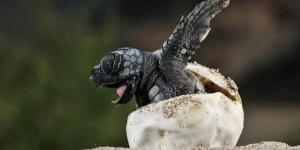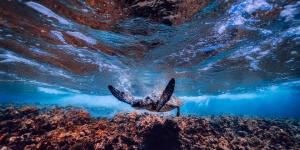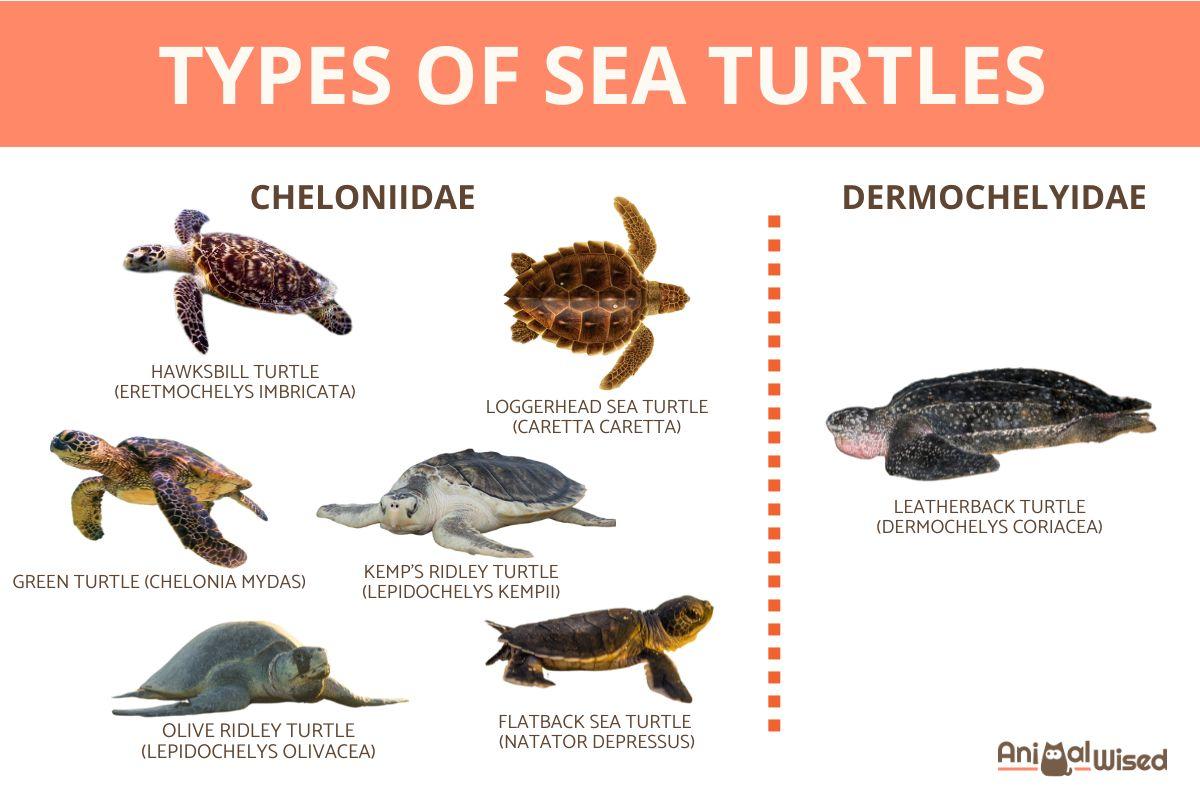What Are the 7 Types of Sea Turtles?


For millions of years, sea turtles have been vital players in our oceans' ecosystems. These incredible reptiles, encompassing seven distinct species, each boast unique characteristics, habitats, and behaviors, from the colossal leatherback to the tenacious Kemp's ridley. Despite their varied sizes, diets, and distributions, all sea turtles share fundamental traits.
In this AnimalWised article, we’ll explore the 7 types of sea turtles, how to identify them, and what makes each one special.
- Characteristics of sea turtles
- Green turtle (Chelonia mydas)
- Hawksbill turtle (Eretmochelys imbricata)
- Loggerhead sea turtle (Caretta caretta)
- Leatherback turtle (Dermochelys coriacea)
- Flatback sea turtle (Natator depressus)
- Olive ridley turtle (Lepidochelys olivacea)
- Kemp's ridley turtle (Lepidochelys kempii)
Characteristics of sea turtles
Sea turtles are marine reptiles that have inhabited Earth's oceans for over 100 million years. These ancient mariners have developed specialized adaptations that allow them to thrive in marine environments while maintaining their reptilian heritage.
All sea turtles share these key features:
- A shell structure composed of an upper carapace and lower plastron that provides protection.
- Streamlined bodies with a hydrodynamic shape that allows for swimming efficiency.
- Modified limbs with front flippers for swimming and rear flippers for steering.
- An air-breathing respiratory system that requires them to surface periodically.
- Extended dive capacity that allows them to stay underwater for 30+ minutes by storing oxygen in blood and muscles.
- Long lifespan with many species living 50-80 years, some reaching over 100 years.
- Natal homing ability to return to their birth beaches to nest after long migrations.
- Late maturity with most reaching reproductive age between 10-30 years depending on species.
- Marine habitat adaptation that keeps them in water for nearly their entire lives, except females when nesting.
- Egg-laying reproduction with females depositing clutches of 80-120 eggs in nests dug on sandy beaches.
While they breathe air through lungs like all reptiles, sea turtles can remain submerged for extended periods thanks to their efficient oxygen storage in blood and muscles, slowed heart rate underwater, and ability to manage blood flow to prioritize vital organs. This allows them to forage, rest, and travel underwater for much of their lives.
Sea turtles are also masters of navigation, undertaking some of the animal kingdom's most impressive migrations. Using Earth's magnetic field, ocean currents, chemical cues, and visual landmarks, they travel thousands of miles between feeding and nesting grounds. The leatherback makes the longest journeys, with documented migrations exceeding 10,000 miles. Most incredibly, female sea turtles return to nest on the very beaches where they hatched decades earlier.
Despite these shared traits, sea turtles have diversified into seven distinct species belonging to two different families. The hard-shelled sea turtles belong to the family Cheloniidae. The family Dermochelyidae, however, contains only the leatherback (Dermochelys coriacea), the largest sea turtle known for its unique leathery shell.
Green turtle (Chelonia mydas)
Despite their name, green turtles (Chelonia mydas) aren't green on the outside. Their carapace (upper shell) ranges from olive to brown, black, or even reddish-brown depending on habitat. The name actually comes from the green fat beneath their shell, which results from their primarily herbivorous adult diet. They're medium to large sea turtles, with adults typically measuring 3-4 feet in shell length and weighing 240-420 pounds.
Green turtles inhabit tropical and subtropical oceans worldwide. Major nesting populations exist in Costa Rica, Australia, Hawaii, Florida, and throughout the Caribbean. They're highly migratory, traveling between feeding grounds and nesting beaches.
Young green turtles are omnivorous, eating small invertebrates, seagrass, and algae. As they mature, they undergo a dietary shift, becoming primarily herbivorous. In fact, they are the only sea turtle species to do so. Adults mainly feed on seagrass and algae, which contributes to their greenish fat.
This makes green turtles vital to maintaining healthy seagrass beds. Their grazing keeps seagrass short and promotes new growth, similar to how lawn mowing stimulates grass growth. These seagrass ecosystems serve as nurseries for many commercially important fish species and help stabilize coastal areas.
Females return to their natal beaches every 2-4 years to nest, often making journeys of thousands of miles. They typically lay 3-5 clutches per season, with about 100 eggs per clutch. The eggs incubate for approximately 60 days, and like all sea turtles, the hatchlings' sex is determined by incubation temperature.
Green turtles are listed as endangered on the IUCN Red List. Their populations declined dramatically due to harvesting for meat and eggs, habitat destruction, plastic pollution, fishing bycatch, and climate change.
Want to know how sea turtles hatch? Check out our article on the sea turtle birth process.

Hawksbill turtle (Eretmochelys imbricata)
Named for their distinctive narrow, pointed beak resembling a hawk's bill, hawksbill turtles (Eretmochelys imbricata) are easily identified by their appearance. Their main feature is their shell (carapace) with overlapping scales (scutes) that create a serrated edge. These scutes display a pattern of amber, yellow, and brown marbling. Which unfortunately has made them targets for the tortoiseshell trade throughout history. Hawksbills are medium-sized, typically reaching only 2-3 feet in shell length and weighing between 100-150 pounds.
In tropical and subtropical waters of the Atlantic, Pacific, and Indian Oceans, these sea turtles live primarily around coral reefs, rocky areas, lagoons, and shallow coastal regions. While swimming through these diverse habitats, they add significantly to marine ecosystems. The Caribbean, Indonesia, Australia, and parts of the Middle East host the largest nesting populations of these turtles.
Unlike other sea turtle species, hawksbills have evolved as specialized feeders with a diet mostly of sponges, an unusual food choice that makes up 70-95% of what they eat in many regions. This diet preference is interesting since many sponges contain toxic compounds that keep most other predators away. Using their pointed beak to extract sponges from tight spaces in reef crevices, they sometimes also eat jellyfish, sea anemones, squid, and other invertebrates.
Coral reef biodiversity improves thanks to the hawksbill's feeding habits. By controlling sponge populations, these turtles prevent the fast-growing organisms from overtaking slow-growing corals for reef space. This helps maintain the structure and diversity of coral reef ecosystems that many marine species depend on for survival.
More solitary than other sea turtle species, these agile swimmers move through complex reef structures with precision. As they travel through ocean waters, their shells often become living platforms for barnacles and other marine hitchhikers, creating small traveling ecosystems that further add to their ecological importance.
The IUCN Red List classifies hawksbills as critically endangered, with populations down by over 80% in many regions. Despite international protection through CITES banning the tortoiseshell trade, illegal harvesting continues alongside growing threats from habitat loss of important coral reef ecosystems.

Loggerhead sea turtle (Caretta caretta)
The loggerhead sea turtle (Caretta caretta) gets its name from its large head and strong jaws. These turtles have a reddish-brown, heart-shaped shell that tapers slightly toward the back. Adult loggerheads typically measure 2.5-3.5 feet long and weigh between 175-400 pounds, making them the largest hard-shelled sea turtle species.
Found in temperate and subtropical waters across the Atlantic, Pacific, and Indian Oceans, loggerheads migrate extensively. Major nesting beaches include Florida (USA), Oman, Australia, Japan, and Mediterranean countries. Some populations travel over 8,000 miles between feeding and nesting grounds.
Their large head and strong jaws help loggerheads eat hard-shelled prey that other animals can't access. Their diet includes crabs, shrimps, clams, mussels, horseshoe crabs, sea urchins, and jellyfish.
Loggerheads help marine environments as they dig for food in soft-bottom habitats, stirring up sediments and spreading nutrients. Their feeding on hard-shelled animals helps control prey populations and maintain ecosystem balance. Their shells also serve as mobile homes for over 100 species of small plants and animals.
The loggerhead life cycle is well-studied. After hatching, young turtles enter the "lost years" in the open ocean. Juveniles spend 7-12 years drifting in ocean currents, often near floating seaweed. Sub-adults then move to coastal feeding grounds. Sexual maturity arrives at 17-33 years of age. Adults may live 70+ years in the wild. Loggerheads have helped scientists understand sea turtle biology.
Their size made them easier to track in early satellite studies, helping researchers discover migration routes and behavior patterns. They've also been important for studying how sea turtles navigate, as they use Earth's magnetic field to guide their long oceanic trips.
Listed as vulnerable on the IUCN Red List, loggerheads face several threats. Getting caught in fishing gear, especially longlines and trawls, poses a major danger. Beach development affects nesting sites, while light pollution confuses hatchlings. Plastic pollution and climate change affecting sex ratios and nesting beaches further threaten their survival.

Leatherback turtle (Dermochelys coriacea)
The leatherback turtle (Dermochelys coriacea) stands apart from all other sea turtles as the only species without a hard shell. Instead, these giants have a leathery, flexible carapace made of tough, oil-saturated connective tissue and tiny bone plates. Their dark, ridged back often appears bluish-black with white or pale spots. The largest of all sea turtles, leatherbacks can grow over 7 feet long and weigh up to 2,000 pounds.
Leatherbacks have the widest global distribution of any reptile, found in tropical, subtropical, and even cold temperate waters of the Atlantic, Pacific, and Indian Oceans. They can maintain body temperatures up to 18°F above the surrounding water, allowing them to swim in cold waters that would stun other sea turtles. These long-distance swimmers hold migration records among sea turtles, with some traveling over 10,000 miles annually between feeding and nesting grounds.
Leatherbacks feed almost exclusively on jellyfish and other soft-bodied organisms. Their specialized digestive system includes backward-pointing spines in their throat and esophagus that help them trap slippery prey. To sustain their massive size on such low-calorie food, leatherbacks consume enormous quantities of jellyfish, up to their own body weight daily.
Leatherbacks help control jellyfish populations, preventing problematic blooms that can affect fish stocks and beach use.
Leatherbacks have existed in nearly their current form for over 100 million years, surviving the extinction that wiped out the dinosaurs. Their unique evolutionary adaptations for deep diving, including flexible shells, collapsible lungs, and specialized blood vessel arrangements, make them living examples of successful adaptation.
The IUCN lists leatherbacks as vulnerable globally, though some subpopulations in the Pacific are critically endangered. Main threats include egg collection, coastal development, fishing gear entanglement, plastic ingestion (they often mistake floating bags for jellyfish), vessel strikes, and climate change. Their nesting beaches face erosion from rising sea levels, and warming temperatures may skew hatchling sex ratios.
Curious about the journey sea turtles take from egg to adulthood? Check out our companion article on their complete life cycle.

Flatback sea turtle (Natator depressus)
The flatback turtle (Natator depressus) is the only sea turtle species found exclusively in the waters around Australia. Its name comes from its relatively flat, olive-gray carapace (upper shell) that lacks the high dome shape seen in other sea turtles. This medium-sized sea turtle typically grows to about 3 feet in length and weighs between 150-200 pounds.
Flatbacks were scientifically described later than other sea turtle species, formally classified in 1988. Before this, they were sometimes confused with green turtles or olive ridleys. Their study has been hampered by their preference for murky waters, making observation difficult.
Unlike other sea turtle species that roam across ocean basins, flatbacks maintain a limited range within the continental shelf waters of northern Australia, Papua New Guinea, and Indonesia. They prefer shallow, turbid waters and stay close to the coast throughout their lives. This restricted distribution makes them unique among sea turtles, which typically have global or wide regional distributions.
Flatbacks feed primarily on soft-bodied invertebrates found on the sea floor. Their diet includes sea cucumbers, soft corals, jellyfish, sea pens, shrimp, and other bottom-dwelling creatures. They rarely dive deep, instead foraging in coastal waters less than 200 feet deep, where their preferred prey is abundant.
The flatback life cycle differs from other sea turtles because they lack an oceanic phase. While most sea turtle hatchlings head to the open ocean for several years, young flatbacks stay in coastal waters near their nesting beaches. This behavior potentially exposes them to more threats in these heavily used coastal zones but reduces risks associated with long migrations.
Though listed as "data deficient" by the IUCN, flatbacks face numerous conservation challenges. Their restricted range makes them vulnerable to regional threats including coastal development, water pollution, fishing activities, and indigenous harvest of eggs and adults in some areas.

Olive ridley turtle (Lepidochelys olivacea)
The olive ridley turtle (Lepidochelys olivacea) is named for its olive-green, heart-shaped carapace. These smaller sea turtles typically measure 2-2.5 feet in shell length and weigh 80-110 pounds, making them the second smallest sea turtle species. Their shell is slightly higher domed than their close relative, the Kemp's ridley, and adults often have an irregular number of scutes (shell plates) compared to other sea turtles.
Found throughout tropical and subtropical waters of the Pacific, Indian, and Atlantic Oceans, olive ridleys prefer the open ocean. They inhabit coastal areas during nesting season but spend most of their lives in the pelagic zone, often in waters 100-200 feet deep.
Olive ridleys are omnivorous with a varied diet. They feed mainly on jellyfish, crabs, shrimp, snails, algae, fish eggs, and occasional seaweed. Their jaws are well-adapted for crushing prey with hard shells, allowing them to access food sources unavailable to other sea turtle species in their habitat range.
These turtles are best known for their mass nesting behavior called "arribada". During arribadas, thousands of females come ashore simultaneously at specific beaches to lay eggs, creating one of nature's most impressive nesting spectacles. Only olive ridleys and their close relatives, Kemp's ridleys, display this synchronized nesting behavior.
Listed as vulnerable by the IUCN, olive ridleys face many threats. Historical egg collection and turtle harvesting caused severe population declines. Their arribada nesting makes them vulnerable to concentrated harvesting, though this practice is now illegal in most countries.
Conservation efforts focus on protecting nesting beaches, especially during arribadas, and reducing fisheries bycatch through Turtle Excluder Devices (TEDs) in trawl nets. While some populations show signs of recovery, particularly in Mexico and Costa Rica, others continue to decline.
Among sea turtles, olive ridleys currently have the highest global population numbers, estimated at around 800,000 nesting females annually, yet they still require significant conservation attention to ensure their long-term survival.

Kemp's ridley turtle (Lepidochelys kempii)
The Kemp's ridley turtle (Lepidochelys kempii) is the smallest and most endangered sea turtle species in the world. Adults typically measure just 2 feet in length and weigh 70-100 pounds. Their carapace is almost circular when viewed from above, with a gray-olive color that darkens as they age.
This species has the most restricted range of all sea turtles, primarily found in the Gulf of Mexico and along the eastern seaboard of the United States. Unlike other sea turtles that nest across multiple beaches throughout their range, Kemp's ridleys nest almost exclusively on a specific stretch of beach near Rancho Nuevo, Mexico, with smaller nesting colonies in Texas and other parts of the Gulf coast.
Kemp's ridleys feed mainly on crabs, particularly blue crabs, which make up the bulk of their diet. They also consume clams, mussels, shrimp, sea urchins, fish, and occasionally seaweed. These turtles forage in shallow waters of bays, lagoons, and inshore waters where crustaceans are abundant, rarely venturing into deep ocean waters.
Like their close relatives the olive ridleys, Kemp's ridleys display the unique mass nesting behavior called "arribada." However, they take this synchronization even further. Not only do they nest in large groups, but they do so during daylight hours. This behavior may have evolved to overwhelm predators through sheer numbers, improving overall hatchling survival rates.
Historically, the Kemp's ridley population collapsed dramatically between the 1940s and 1980s. From an estimated 40,000 nesting females in 1947 to fewer than 300 by the mid-1980s, they experienced one of the most severe declines of any sea turtle species. This crash resulted from egg harvesting, adult hunting, and fisheries bycatch.
Conservation efforts for Kemp's ridleys represent one of the most intensive wildlife recovery programs ever undertaken. Mexico and the United States collaborate to protect nesting beaches, enforce fishing regulations, and reintroduce hatchlings.
These efforts produced promising results, with nesting numbers increasing from 1996 to 2009. However, the 2010 Deepwater Horizon oil spill in the Gulf of Mexico affected key habitat areas, and recent nesting trends show concerning fluctuations.
If you enjoyed this article, you might also like our guide on how turtles interact and communicate with each other.

If you want to read similar articles to What Are the 7 Types of Sea Turtles?, we recommend you visit our Facts about the animal kingdom category.
- Abreu-Grobois, A & Plotkin, P. (IUCN SSC Marine Turtle Specialist Group). (2008). Lepidochelys olivacea . The IUCN Red List of Threatened Species 2008: e.T11534A3292503. https://dx.doi.org/10.2305/IUCN.UK.2008.RLTS.T11534A3292503.en.
- Casale, P. & Tucker, A.D. (2017). Caretta caretta (amended version of 2015 assessment) . The IUCN Red List of Threatened Species 2017: e.T3897A119333622. https://dx.doi.org/10.2305/IUCN.UK.2017-2.RLTS.T3897A119333622.en.
- Eckert, K.L., Bjorndal, K.A., Abreu-Grobois, F.A., & Donnelly, M. (2000). Introduction to the evolution, life histories, and biology of sea turtles . Research and Management Techniques for Sea Turtle Conservation, 3.
- Mortimer, JA & Donnelly, M. (IUCN SSC Marine Turtle Specialist Group). (2008). Eretmochelys imbricata . The IUCN Red List of Threatened Species 2008: e.T8005A12881238. https://dx.doi.org/10.2305/IUCN.UK.2008.RLTS.T8005A12881238.en.
- Ricardo, JA, Peña, RC, Guerra, CC, González, YM, Avila, RB, & Álvarez, PP (2023). Vulnerability of sea turtle nesting areas to climate change . Annals of the Cuban Academy of Sciences, 13(2), 1296.
- Seminoff, JA (Southwest Fisheries Science Center, US). (2004). Chelonia mydas . The IUCN Red List of Threatened Species 2004: e.T4615A11037468. https://dx.doi.org/10.2305/IUCN.UK.2004.RLTS.T4615A11037468.en.
- Wallace, B.P., Tiwari, M. & Girondot, M. (2013). Dermochelys coriacea . The IUCN Red List of Threatened Species 2013: e.T6494A43526147. https://dx.doi.org/10.2305/IUCN.UK.2013-2.RLTS.T6494A43526147.en.
- Wibbels, T. & Bevan, E. (2019). Lepidochelys kempii (errata version published in 2019). The IUCN Red List of Threatened Species 2019: e.T11533A155057916. https://dx.doi.org/10.2305/IUCN.UK.2019-2.RLTS.T11533A155057916.en.












